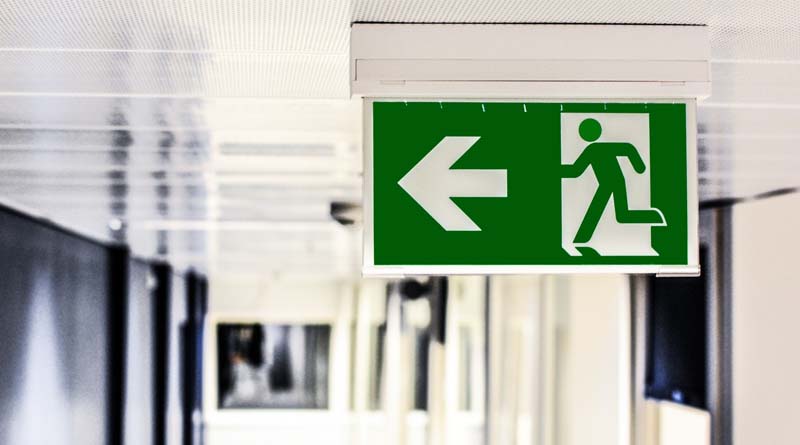By James Florentino
It’s important for all businesses to have emergency evacuation plans, especially if it’s a medical facility. Hospital emergency rooms are filled with patients seeking treatment for accidental injuries or issues that require immediate care, but very rarely does anyone stop to consider that the very place that treats the consequences of accidents can be the very place where they occur.
Take, for example, a natural disaster that puts a hospital in the dark, because a back-up generator has failed; or a fire that not only wipes out electricity, but creates smoke and fumes. It’s not always easy to find an exit when you can’t see or perhaps even breathe easily. This type of an incident is compounded when it occurs on the 15th floor and visitors, staff and ambulatory patients must get down flights of stairs and out to safety. In the event of an emergency, even the most basic of tasks can be more difficult than the most complex of mazes.
In these situations, it’s not only the physical challenges of seeing your way to safety, but the ensuing panic and confusion that can make it difficult to follow the most basic of directions. This is why planning your exit routes as a part of health and safety is a necessity for businesses. Many companies outsource health and safety advice to gain a professional opinion on how to best protect both employees and visitors in a situation like this. Because of this, clearly marked evacuation routes can mean life or death for those that occupy hospitals and other health facilities. Further, having a plan for egress can not only help people get out of buildings, but it can also help rescue teams get in.
Most hospitals have their own emergency preparedness plans for full or partial evacuation of patients. These plans usually follow local community guidance and consist of agreements with other hospitals, as well as clear protocols for transfer of mutual aid during an emergency, along with transfer of medications, supplies, equipment, medical records summaries and patient tracking.
While such emergency preparedness plans are not required by law, what is required is safe egress for staff and visitors. The Occupational Safety and Health Administration (OSHA) requires that exit routes meet specific design and construction requirements, that there must be a number of exits based on the number of employees and other specific requirements including emergency exit signage that ensure safe evacuation of workers.
While OSHA does not require facilities to have a printed map for evacuation in the case of an emergency, other governmental agencies, such as state and local agencies, fire departments or even insurance carriers, often do. In fact, most healthcare facilities provide clearly marked safety egress plans. So how can these plans most effectively be implemented?
Below are five best practices and procedures for safe egress from a hospital or health facility:
- Make sure all plans are visible and understood. It’s wise to have an evacuation map and procedure that is clearly understood by all staff and visitors. Evacuation maps should be clearly displayed throughout the building, including corridors and rooms where exit locations are not as obvious.
- Practice safety drills. Regular safety drills should be performed to practice safe exiting, as well as work out any kinks in the process.
- Clearly articulate when it’s best to shelter in place. While many dangerous incidents require fast exit, there may be cases when it’s safer to shelter in place, for example in the event of an earthquake. Make sure you run through these scenarios with all staff and ensure everyone understands the protocol.
- Provide highly visible exit signs and pathways. It’s important to provide clear markings toward exit routes, that are visible in the dark and can light the way to safe exits.
- Account for everyone. Identify and train personnel on each floor of a building who will be responsible for getting people out, and making sure everyone is accounted for. A visitor management system can assist by providing a digital visitor log, which can help to account for all visitors in the building.
Lighting up the Path to Safety
While it’s key to make sure exit paths are clearly illuminated, this can be a problem when the electricity goes out and you’re in complete darkness. Traditional protocols have used electric lights that show the way, or relied on back-up battery power to keep the lights on. Safety standards require that emergency lights last for 90 minutes in the event of a power outage. Today there are new options to choose from.
Photoluminescent paints can provide light without electricity to provide safe egress and disaster recovery. Safety managers can use these types of coatings as well as ink and tape products. Unlike traditional glow-in-the-dark products, these luminescent types of coatings can provide a broad spectrum of high intensity day or night-time colors that are extremely resilient, bright and can be applied to many different surfaces, such as wood, plastic, asphalt, cement, metal and fabric.
Photoluminescent coatings can be used for safe egress markings on pathways, stair treads, railings. Also, at a time when sustainability is a key goal of many health institutions these types of coatings use zero energy and require no maintenance.
With increasing extreme weather events and other emergency situations, protecting your hospital or health facility and the people in it requires a clear exit strategy. Properly illuminating the route to safety through visible and reliable egress – even when the lights are out – can be just what the doctor ordered when it to ensuring peace of mind amidst what can be a chaotic situation.
James Florentino is the director of business development at Bambu Global, a technology company providing breakthrough color and light solutions for a variety of markets.


